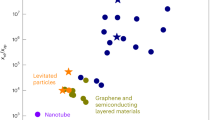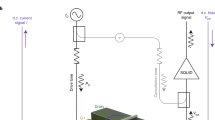Abstract
Nanomechanical resonators are used with great success to couple mechanical motion to other degrees of freedom, such as photons, spins and electrons1,2. The motion of a mechanical eigenmode can be efficiently cooled into the quantum regime using photons2,3,4, but not other degrees of freedom. Here, we demonstrate a simple yet powerful method for cooling, amplification and self-oscillation using electrons. This is achieved by applying a constant (d.c.) current of electrons through a suspended nanotube in a dilution refrigerator. We demonstrate cooling to 4.6 ± 2.0 quanta of vibrations. We also observe self-oscillation, which can lead to prominent instabilities in the electron transport through the nanotube. We attribute the origin of the observed cooling and self-oscillation to an electrothermal effect. This work shows that electrons may become a useful resource for cooling the mechanical vibrations of nanoscale systems into the quantum regime.
This is a preview of subscription content, access via your institution
Access options
Access Nature and 54 other Nature Portfolio journals
Get Nature+, our best-value online-access subscription
$29.99 / 30 days
cancel any time
Subscribe to this journal
Receive 12 print issues and online access
$209.00 per year
only $17.42 per issue
Buy this article
- Purchase on Springer Link
- Instant access to full article PDF
Prices may be subject to local taxes which are calculated during checkout




Similar content being viewed by others
References
Treutlein, P., Genes, C., Hammerer, K., Poggio, M. & Rabl, P. Hybrid Mechanical Systems (Springer, 2014).
Aspelmeyer, M., Kippenberg, T. J. & Marquardt, F. Cavity optomechanics. Rev. Mod. Phys. 86, 1391–1452 (2014).
Clark, J. B., Lecocq, F., Simmonds, R. W., Aumentado, J. & Teufel, J. D. Sideband cooling beyond the quantum backaction limit with squeezed light. Nature 541, 191–195 (2017).
Rossi, M., Mason, D., Chen, J., Tsaturyan, Y. & Schliesser, A. Measurement-based quantum control of mechanical motion. Nature 563, 53–58 (2018).
Knobel, R. G. & Cleland, A. N. Nanometre-scale displacement sensing using a single electron transistor. Nature 424, 291–293 (2003).
Woodside, M. T. & McEuen, P. L. Scanned probe imaging of single-electron charge states in nanotube quantum dots. Science 296, 1098–1101 (2002).
Lassagne, B., Tarakanov, Y., Kinaret, J., Garcia-Sanchez, D. & Bachtold, A. Coupling mechanics to charge transport in carbon nanotube mechanical resonators. Science 325, 1107–1110 (2009).
Steele, G. A. et al. Strong coupling between single-electron tunneling and nanomechanical motion. Science 325, 1103–1107 (2009).
Benyamini, A., Hamo, A., Kusminskiy, S. V., von Oppen, F. & Ilani, S. Real-space tailoring of the electron–phonon coupling in ultraclean nanotube mechanical resonators. Nat. Phys. 10, 151–156 (2014).
Ares, N. et al. Resonant optomechanics with a vibrating carbon nanotube and a radio-frequency cavity. Phys. Rev. Lett. 117, 170801 (2016).
Okazaki, Y., Mahboob, I., Onomitsu, K., Sasaki, S. & Yamaguchi, H. Gate-controlled electromechanical backaction induced by a quantum dot. Nat. Commun. 7, 11132 (2016).
Götz, K. J. G. et al. Nanomechanical characterization of the Kondo charge dynamics in a carbon nanotube. Phys. Rev. Lett. 120, 246802 (2018).
Singh, V. et al. Coupling between quantum Hall state and electromechanics in suspended graphene resonator. Appl. Phys. Lett. 100, 233103 (2012).
Chen, C. et al. Modulation of mechanical resonance by chemical potential oscillation in graphene. Nat. Phys. 12, 240–244 (2016).
Clerk, A. A. & Bennett, S. Quantum nanoelectromechanics with electrons, quasi-particles and cooper pairs: effective bath descriptions and strong feedback effects. New J. Phys. 7, 238 (2005).
Armour, A. D., Blencowe, M. P. & Zhang, Y. Classical dynamics of a nanomechanical resonator coupled to a single-electron transistor. Phys. Rev. B 69, 125313 (2004).
Naik, A. et al. Cooling a nanomechanical resonator with quantum back-action. Nature 443, 193–196 (2006).
Zippilli, S., Morigi, G. & Bachtold, A. Cooling carbon nanotubes to the phononic ground state with a constant electron current. Phys. Rev. Lett. 102, 096804 (2009).
Santandrea, F., Gorelik, L. Y., Shekhter, R. I. & Jonson, M. Cooling of nanomechanical resonators by thermally activated single-electron transport. Phys. Rev. Lett. 106, 186803 (2011).
Stadler, P., Belzig, W. & Rastelli, G. Ground-state cooling of a carbon nanomechanical resonator by spin-polarized current. Phys. Rev. Lett. 113, 047201 (2014).
Arrachea, L., Bode, N. & von Oppen, F. Vibrational cooling and thermoelectric response of nanoelectromechanical systems. Phys. Rev. B 90, 125450 (2014).
Stadler, P., Belzig, W. & Rastelli, G. Ground-state cooling of a mechanical oscillator by interference in Andreev reflection. Phys. Rev. Lett. 117, 197202 (2016).
Laird, E. A. et al. Quantum transport in carbon nanotubes. Rev. Mod. Phys. 87, 703–764 (2015).
Hamo, A. et al. Electron attraction mediated by Coulomb repulsion. Nature 535, 395–400 (2016).
Deshpande, V. V. & Bockrath, M. The one-dimensional Wigner crystal in carbon nanotubes. Nat. Phys. 4, 314–318 (2008).
Moser, J., Eichler, A., Güttinger, J., Dykman, M. I. & Bachtold, A. Nanotube mechanical resonators with quality factors of up to 5 million. Nat. Nanotechnol. 9, 1007–1011 (2014).
Hüttel, A. K. et al. Carbon nanotubes as ultrahigh quality factor mechanical resonators. Nano Lett. 9, 2547–2552 (2009).
de Bonis, S. L. et al. Ultrasensitive displacement noise measurement of carbon nanotube mechanical resonators. Nano Lett. 18, 5324–5328 (2018).
Khivrich, I., Clerk, A. A. & Ilani, S. Nanomechanical pump–probe measurements of insulating electronic states in a carbon nanotube. Nat. Nanotechnol. 14, 161–167 (2019).
Song, X., Oksanen, M., Li, J., Hakonen, P. J. & Sillanpää, M. A. Graphene optomechanics realized at microwave frequencies. Phys. Rev. Lett. 113, 027404 (2014).
Weber, P., Güttinger, J., Noury, A., Vergara-Cruz, J. & Bachtold, A. Force sensitivity of multilayer graphene optomechanical devices. Nat. Commun. 7, 12496 (2016).
Steeneken, P. G. et al. Piezoresistive heat engine and refrigerator. Nat. Phys. 7, 354–359 (2011).
Barton, R. A. et al. Photothermal self-oscillation and laser cooling of graphene optomechanical systems. Nano Lett. 12, 4681–4686 (2012).
Bocquillon, E. et al. Coherence and indistinguishability of single electrons emitted by independent sources. Science 339, 1054–1057 (2013).
Jullien, T. et al. Quantum tomography of an electron. Nature 514, 603–607 (2014).
Banerjee, M. et al. Observation of half-integer thermal Hall conductance. Nature 559, 205–210 (2018).
Pistolesi, F. & Labarthe, S. Current blockade in classical single-electron nanomechanical resonator. Phy. Rev. B 76, 165317 (2007).
Zhu, J., Brink, M. & McEuen, P. L. Frequency shift imaging of quantum dots with single-electron resolution. Appl. Phys. Lett. 87, 242102 (2005).
Stomp, R. et al. Detection of single-electron charging in an individual InAs quantum dot by noncontact atomic-force microscopy. Phys. Rev. Lett. 94, 056802 (2005).
LaHaye, M. D., Suh, J., Echternach, P. M., Schwab, K. C. & Roukes, M. L. Nanomechanical measurements of a superconducting qubit. Nature 459, 960–964 (2009).
Bennett, S. D., Cockins, L., Miyahara, Y., Grütter, P. & Clerk, A. A. Strong electromechanical coupling of an atomic force microscope cantilever to a quantum dot. Phys. Rev. Lett. 104, 017203 (2010).
Pirkkalainen, J.-M. et al. Cavity optomechanics mediated by a quantum two-level system. Nat. Commun. 6, 6981 (2015).
Deng, G.-W. et al. Strongly coupled nanotube electromechanical resonators. Nano Lett. 16, 5456–5462 (2016).
Sazonova, V. et al. A tunable carbon nanotube electromechanical oscillator. Nature 431, 284–287 (2004).
Acknowledgements
We thank M. Dykman, F. Pistolesi and D. Chang for discussions. This work is supported by ERC advanced grant number 692876, the Cellex Foundation, the CERCA Programme, AGAUR (grant number 2017SGR1664), Severo Ochoa (grant number SEV-2015-0522), MICINN grant number RTI2018-097953-B-I00 and the Fondo Europeo de Desarrollo Regional. We thank B. Thibeault at UCSB for fabrication help.
Author information
Authors and Affiliations
Contributions
W.Y. fabricated the devices with the support of C.U. and M.J.E. in the growth. C.U. and W.Y. carried out the measurements. C.U., W.Y., S.L.B., C.S., Q.D. and Y.J developed the detection circuit. C.U., W.Y. and A.B. analysed the data and wrote the manuscript. A.B. supervised the work.
Corresponding authors
Ethics declarations
Competing interests
The authors declare no competing interests.
Additional information
Publisher’s note Springer Nature remains neutral with regard to jurisdictional claims in published maps and institutional affiliations.
Supplementary information
Supplementary Information
Supplementary Figs. 1–8, methods and discussion, and references.
Supplementary Data 1
Source data for Fig. 1b.
Supplementary Data 2
Source data for Fig. 2a.
Supplementary Data 3
Source data for Fig. 3.
Supplementary Data 4
Source data for Fig. 4.
Rights and permissions
About this article
Cite this article
Urgell, C., Yang, W., De Bonis, S.L. et al. Cooling and self-oscillation in a nanotube electromechanical resonator. Nat. Phys. 16, 32–37 (2020). https://doi.org/10.1038/s41567-019-0682-6
Received:
Accepted:
Published:
Issue Date:
DOI: https://doi.org/10.1038/s41567-019-0682-6
This article is cited by
-
Strain engineering of nonlinear nanoresonators from hardening to softening
Communications Physics (2024)
-
Nano-assembled open quantum dot nanotube devices
Communications Materials (2024)
-
Nonlinear nanomechanical resonators approaching the quantum ground state
Nature Physics (2023)
-
Signatures and detection prospects for sub-GeV dark matter with superfluid helium
Journal of High Energy Physics (2023)
-
Pumping and Cooling of Nanomechanical Vibrations Generated by Cooper-Pair Exchange
Journal of Low Temperature Physics (2023)



